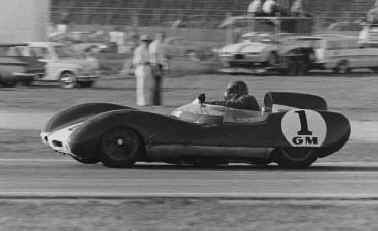|
postscript -- The Lotus 17 |
|
 |
|
|
After two years of dominating the small-bore sports racing classes, late in 1958 the fastest Lotus Elevens could not keep pace with Eric Broadley in his new LOLA. Knowledgeable observers saw the handwriting on the wall, as Broadley’s driving could not explain this speed. The Lola had been designed to beat the Lotus at its’ own game, featuring independent rear suspension, a smaller frontal area and lower weight. Lotus finally needed a replacement for the once all-conquering Eleven. The Lotus Seventeen made its debut in 1959, with
a splash of publicity and advance orders.
Its’ design had been drawn by Len Terry, along parameters laid
out by Colin Chapman. The
specifications were promising: lower
and lighter than either the Eleven or the Lola, with independent
strut-type suspension at each wheel.
In most respects it appeared as a fully updated and improved car,
with a stronger frame, alloy wheels and tighter turning circle. An
easily repaired fiberglass body had a shape that made even the Eleven
look bulky. Yet the 17
could not meet the challenge, and Lotus customer/racers soon reacted
with dismay that not only was it slower than expected, in too many
situations it’s handling was awful. Len Terry claimed to have warned Chapman that the
specified strut front suspension was mechanically flawed in this
application. But
Chapman insisted, and so the design went to production.
In its first races works driver Alan Stacey and others struggled
with the car, and then a protracted period of testing and analysis
began. As the season wore
on and 17s trailed after their competition the factory experimented
with springs and adjustments, managing to improve the handling from
nasty to merely tricky. As
predicted the strut suspension was the problem, binding under hard
cornering force to send the car into abrupt understeer, then just as
suddenly release, causing a lurch to oversteer.
As Mike Costin said, “It nearly killed me and several other
drivers too!” Terry was sacked when he began working on
projects outside the company. And when Chapman discovered one of those
projects was to retrofit a customers’ 17 to wishbone suspension, Lotus
responded by offering its own hastily designed wishbone retrofit to all
owners. This 1959 version
of a factory recall was carried out on all but one of the twenty 17s
built. By the time the 17 was sorted and made
competitive, the 1959 season had already become the year of the Lola and
there was little that Lotus could do about it.
The team was already burdened with: a full season with the
demanding 15 sports-racer, an excruciating F-1 effort with the
troublesome 16, production and racing with the revolutionary Elite, and
a factory move to Cheshunt. Plain bad luck plagued the 17 in race after race, and now the
handwriting predicted mid-engined sports cars for the future.
The 17 was soon forgotten or, even worse, condemned. The 17 shown above had an interesting life.
It was an ex-Team Lotus entry at LeMans sold originally to “Doc” Wyllie. For him, accustomed to the
best Lotus had to offer, it was a profound disappointment.
“The worst car I ever owned” were his exact words.
After the wishbone retrofit at the front failed to improve it
enough, Wyllie converted it to DeDion rear.
Still not happy with the handling, he bought a Lola and sold the
17 to ex-Eleven racer Bill Story for $3,500.
Story, a popular SCCA driver in the Southeast
USA, bought the car without warnings or suspicions, but immediately
switched it from the Eleven-style DeDion back to the original strut IRS.
This time the handling worked.
In the early 1960s this 17 was racing with an assortment of
front, rear and mid-engined cars at club level and was always competitive. It had no
trouble with Lolas either. On
one occasion it was loaned to another respected driver to race, who used
it to slice through a field of substantial racecars, finally hounding an
expertly-driven Porsche RS for the lead*.
Afterwards the driver returned the 17 to the pits and proclaimed,
“I’ve lived my whole life to drive a car like this!”
In the end the Lotus 17 wasn’t a bad car.
It had simply not been fast enough soon enough.
-- Jay Sloane
* The drivers were Dick Dungan in the Lotus and Joe Sheppard in the Porsche. |
|
| HOME | |